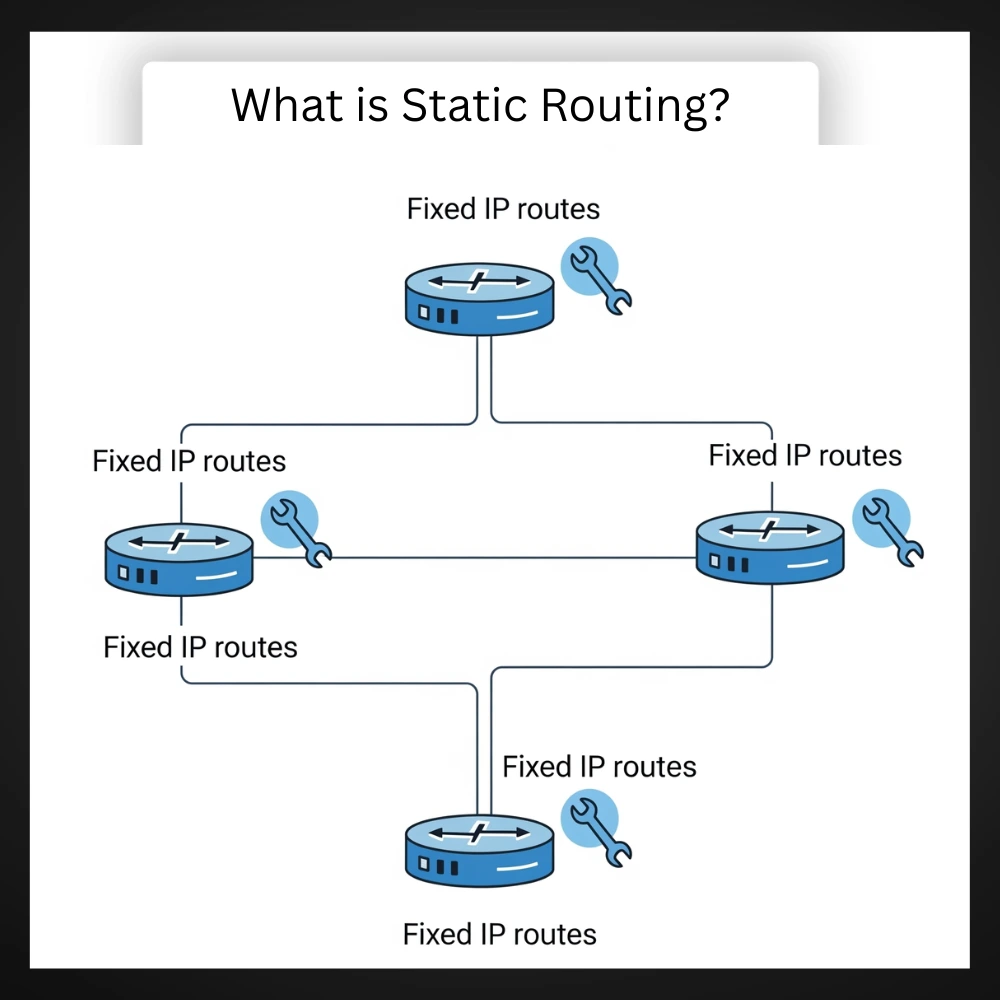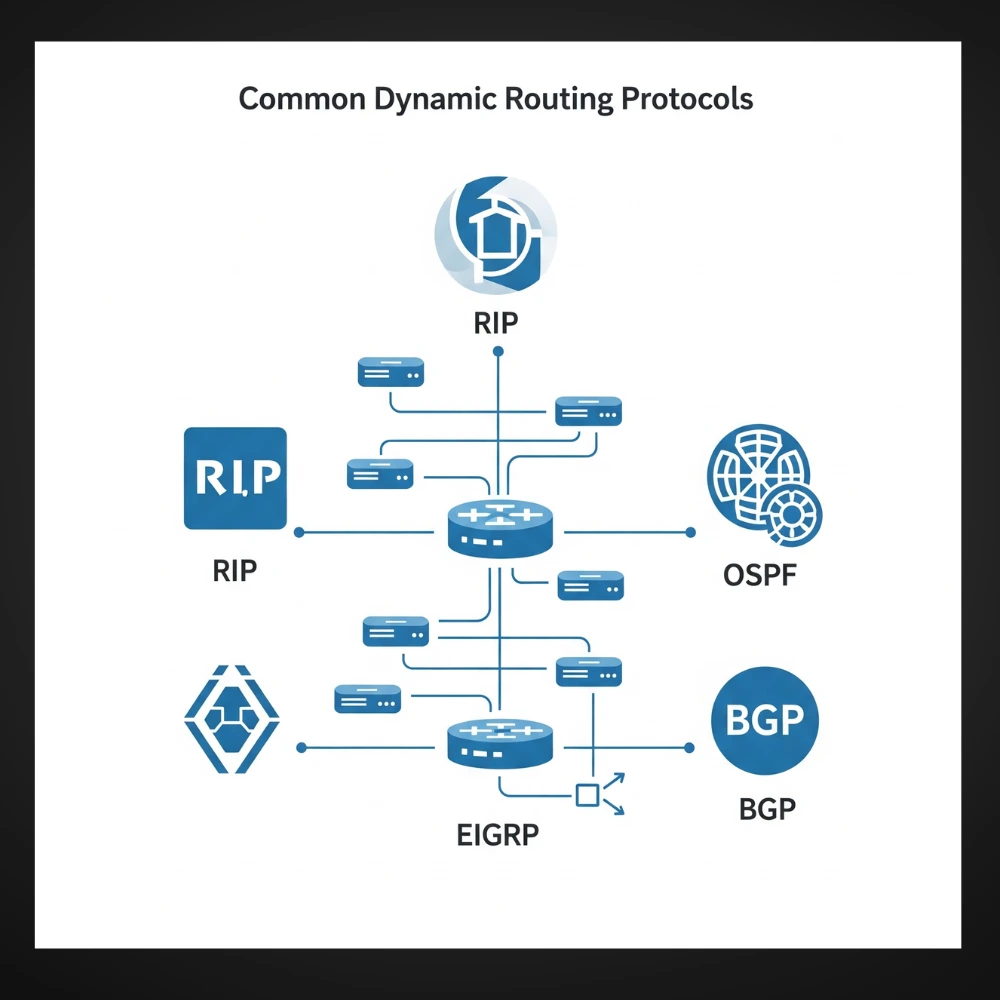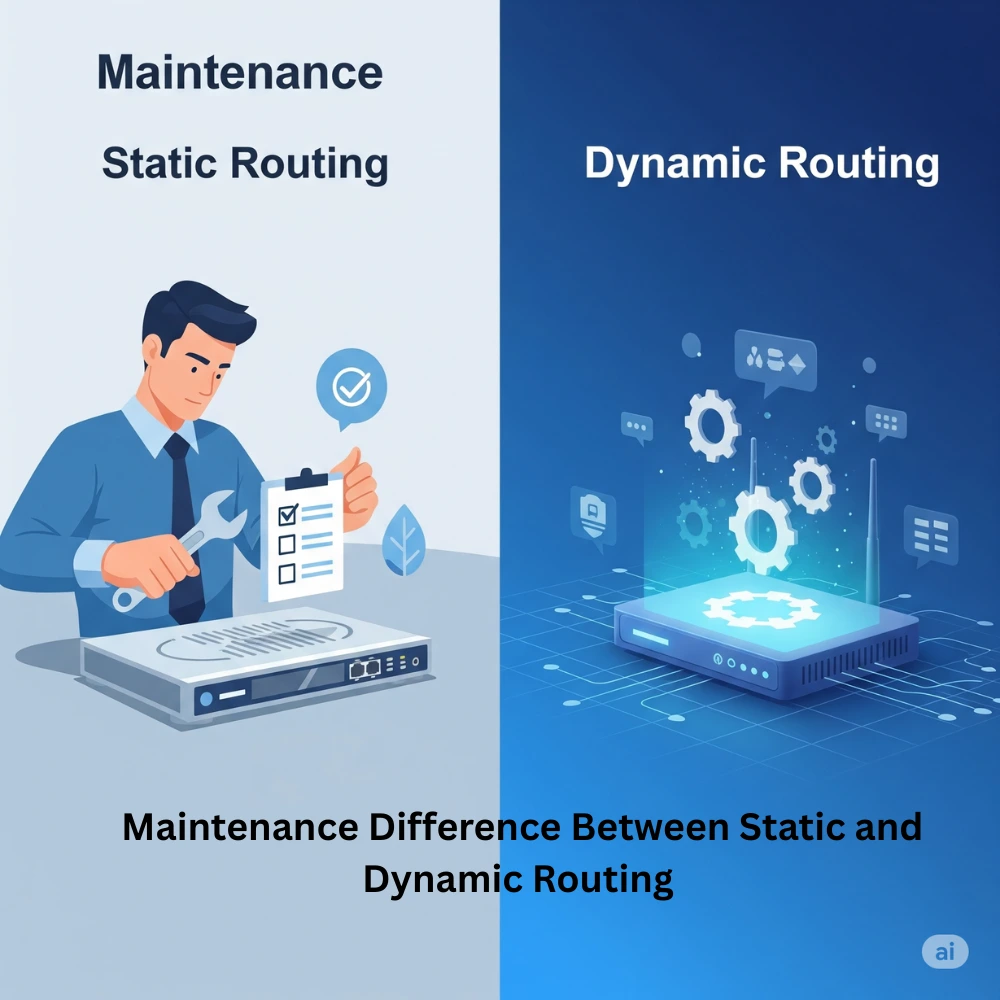In the world of computer networks, data needs to travel from one place to another. To make this possible, routers are used. A router’s job is to choose the best path for sending data across a network. The way a router decides on that path is called routing, and there are two main types of routing: static routing and dynamic routing.
What is Static Routing?
Static routing is a routing method where the network administrator manually sets up the path that data should take through the network. These routes remain the same and only get updated when a network administrator manually modifies them.
How it works?
When a static route is configured, it tells the router exactly where to send data for a particular destination. The router doesn’t need to do any calculations or learn new paths and it simply follows the instructions given.
Key Characteristics of Static Routing
- Set up manually by a network administrator
- Routes do not change automatically
- Requires updates if the network changes
- Uses fewer resources on the router
Example: Imagine you’re giving someone directions to your house. You tell them exactly which roads to take and where to turn. Even if a road is blocked or traffic is heavy, they still follow your original directions. That’s how static routing works, very specific and fixed.
What is Dynamic Routing?
Dynamic routing is more flexible. It allows routers to automatically learn and change the path based on the current condition of the network. Routers using dynamic routing talk to each other and share information.
How it works?
Routers that use dynamic routing share information with each other to learn and update network paths. If one path goes down or becomes too busy, they can choose a better route automatically. They use special communication protocols to do this.
Common Dynamic Routing Protocols
- RIP (Routing Information Protocol)
- OSPF (Open Shortest Path First)
- EIGRP (Enhanced Interior Gateway Routing Protocol)
- BGP (Border Gateway Protocol)
Key Characteristics of Dynamic Routing
- Routes are updated automatically
- Adapts to changes in the network
- Requires more processing power and memory
- Easier to manage in large, complex networks
Example: Think of dynamic routing like using Google Maps. It can tell you the fastest route based on traffic conditions. If there’s an accident ahead, it can suggest a new route. That’s dynamic and smart. It’s just like dynamic routing.
Key Differences Between Static and Dynamic Routing
Let’s now look at the main differences between static and dynamic routing in a simple side by side comparison.
| Feature | Static Routing | Dynamic Routing |
|---|---|---|
| Configuration | Manual | Automatic |
| Flexibility | Low | High |
| Resource Usage | Low CPU and memory use | Higher CPU and memory use |
| Scalability | Not suitable for large networks | Good for large and growing networks |
| Fault Tolerance | Poor | Excellent |
| Maintenance | Time-consuming | Easier (less manual work) |
| Protocols Required | None | Needs routing protocols |
| Security | More secure (no external updates) | Less secure (susceptible to attacks) |
Detailed Comparison: Static vs. Dynamic Routing
To truly understand the difference between static and dynamic routing, it’s helpful to break down each feature in detail.
1. Configuration
- Static Routing: Configured manually by a network administrator. Each route must be entered individually.
- Dynamic Routing: Routers learn routes automatically using protocols like OSPF, RIP, EIGRP or BGP.
Manual configuration reduces risk of errors from external sources but it’s time consuming and error prone at scale.
2. Flexibility
- Static Routing: Rigid and doesn’t adapt to network changes unless manually updated.
- Dynamic Routing: Highly adaptable; if a route fails, it finds an alternative path automatically.
Flexibility is key in enterprise or cloud networks where traffic patterns change often.
3. Resource Usage
- Static Routing: Uses very little processing power and memory.
- Dynamic Routing: Consumes more resources since it must run routing protocols and constantly update route tables.
For small embedded devices or routers with limited memory, static routing is preferred.
4. Scalability
- Static Routing: Becomes hard to manage as the number of networks increases.
- Dynamic Routing: Designed to scale easily, even to the level of the internet (e.g., BGP).
Large organizations or ISPs typically avoid static routes except for special cases.
5. Fault Tolerance
- Static Routing: Static routing does not switch paths automatically if a route fails.
- Dynamic Routing: Automatically reroutes traffic if a path fails.
Dynamic routing ensures better uptime and reliability.
6. Maintenance
- Static Routing: Needs manual updates whenever there’s a network change.
- Dynamic Routing: Self updating; admins can focus on other tasks.
In environments where network changes are frequent, dynamic routing reduces admin workload.
7. Protocols Required
- Static Routing: Does not need any special routing protocols.
- Dynamic Routing: Requires protocols like RIP, OSPF, EIGRP, or BGP.
While this adds complexity, it also provides powerful route optimization and redundancy options.
8. Security
- Static Routing: More secure by default, since it doesn’t accept route updates from other devices.
- Dynamic Routing: Can be less secure if not properly configured; open to spoofed updates or route hijacking.
Dynamic routing can be hardened using authentication and access control lists (ACLs).
When to Use Static Routing?
Static routing is best used in the following cases:
- Small networks with few routers
- Network paths that rarely change
- High security environments where route control is essential
- Backup routes that should only be used if dynamic routes fail
When to Use Dynamic Routing?
Dynamic routing is ideal when:
- You’re managing a medium to large network
- The network topology changes often
- You need automatic failover and route optimization
- You want to reduce manual work and human error
Real Life Scenarios
- Static Routing Example: A small office with two routers connecting to the internet can use static routing. The network is simple, and the internet path does not change. The admin can manually configure the route without needing complex setups.
- Dynamic Routing Example: A large organization with multiple branch offices, cloud services and redundant internet connections will benefit from dynamic routing. If one link fails, dynamic routing ensures the data still gets to its destination by finding another way.
Final Thoughts
Both static and dynamic routing play important roles in managing networks. Static routing gives you control and simplicity but requires more manual work. Dynamic routing is smarter and more flexible but needs more processing power and setup.
The right choice depends on your network’s size, structure and specific requirements. In many modern networks, a combination of both are called hybrid routing is used to get the best of both worlds.



